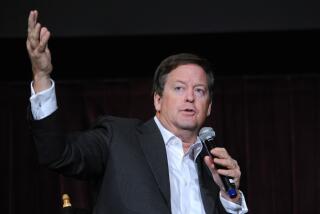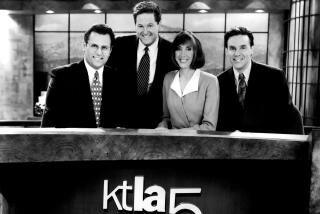An Apple for Veteran Newsman Hal Fishman : Television: The KTLA anchor uses his experience as a teacher to inform viewers about the complexities of today’s news events.
- Share via
Old teachers never die, they just bring their chalk-and-blackboard mentality to the local news.
Lesson No. 1: In August, just after Iraqi troops invaded Kuwait, KTLA Channel 5 anchorman Hal Fishman dug up his Michelin road map of the Middle East desert to help illustrate the treacherous route that a convoy of buses filled with American and British women and children would have to navigate to escape Kuwait City. He set the map on an easel behind him on the news set, got out his pointer and explained: “They have to drive some 550 miles, up here on Highway 7, which cuts right here through the Tigris Euphrates Valley. It’s a very difficult road; you can see here that there is broken pavement for much of the way. It’s very hot, and they have to go all the way up here to Baghdad.”
In a television age stuffed with fancy computer graphics and expensive Italian suits, Fishman retains the same professorial approach to communicating the day’s events that he once employed as a political science teacher at Cal State Los Angeles. The same approach that has kept him on the air here for 30 years. The same approach that has made KTLA the dominant news force among the independent stations for more than a decade.
“I always describe him as a walking encyclopedia,” said Jeff Wald, who served as Fishman’s news director at KTLA for nine years before jumping to KCOP Channel 13 last spring. “He has an uncanny ability for remembering facts and a tremendous brain. Of all the anchor people in this town, he is probably most worthy of the job of anchorman. He knows the material better than what is written in his copy or what comes in on the wires. That’s no slap to the writers, but he is so into his job, he can usually ad-lib better than what the writers can write for him.”
Lesson No. 2: While reading copy about Iraqi troops entering the French Embassy in Kuwait, Fishman decided to improvise. He looked into the camera and explained to his audience the nature of an embassy under international law, reminding viewers of the 1979 takeover of the U.S. Embassy in Tehran.
“I’ve always looked at broadcasting as a continuation of my teaching,” Fishman said in a recent interview. “Back when I started in 1960, people were intrigued just by the phenomenon of television, just by the picture coming into their house. But with the Vietnam War and Watergate, people became skeptical. They don’t trust things so readily. And they want to get the news from people who know what they’re talking about.
“When I think of the hundreds of anchors who have come and gone over the last 30 years, many of them better-looking and better-coiffed than I ever was . . . there was one area that they were not better and that is in being dedicated to being informed. And I think the audience perceives that. I am not a charismatic broadcaster or a dramatic guy, but I think I am a person that people can trust to give them a straightforward and accurate account of what’s going on in the world. I think that’s why I have lasted so long.”
And he’s not about to go away any time soon. Fishman recently signed an extension to his contract at KTLA, locking him up there for at least the next five years. While Channel 5 management has been eager to disavow recent reports that Fishman’s new contract puts him in the $1 million-a-year club with KABC-TV Channel 7’s Paul Moyer and KCAL Channel 9’s Jerry Dunphy, sources say the contract at the very least is worth $750,000 annually.
Not bad for a guy who started his TV career making $100 a week, teaching a college course on the air about American politics in the summer of 1960. An executive at KCOP saw it, offered him a job as a news commentator, and he has been on the air in Los Angeles ever since--always on one of the four independent stations.
Since 1975, Fishman has been KTLA’s anchor, commentator and managing editor, and for most of his tenure there, the station has dominated the 10 p.m. news ratings with a traditional, straightforward, no-nonsense approach. Even as rival independents KTTV Channel 11, KCAL and, most recently, KCOP have been beefing up their news operations and pledging to topple KTLA, Fishman’s audience has remained steady and strong.
“I believe that if you have something very successful that has weathered the test of time and you don’t change it, I don’t think the competition has a chance of eating into your audience,” said Steve Bell, KTLA’s general manager. “They might be able to build their own audience, but not at your expense. The only way you lose is if you change something radically that irritates your audience. Since we’re not intending to do that, I think we’re pretty safe.”
“We are a constant factor,” said KTLA news director Warren Cereghino, explaining his station’s success. “We don’t have new anchors every few months like some of our competitors. People know Hal Fishman is here at 10 p.m. every weeknight. And Larry McCormick (who has been at KTLA since 1972) is here on the weekends. If you went out on the street and asked people who our anchors are, they’d know. But I doubt they could tell you the name of even one anchor at any of the other three (independent) stations.”
Channel 13, which hired Wald away from Channel 5 last spring and is sinking several million dollars into an invigorated news department, tried to remedy that identity problem by luring Fishman up the dial as well. KCBS Channel 2 is also rumored to have been interested in KTLA’s longtime centerpiece. But as of this summer, Fishman still had two years remaining on his contract at KTLA, which prevented him from making any new commitments. Nonetheless, KTLA felt compelled to keep its star happy and to squash its competitors’ dreams of 1992 by offering Fishman a three-year extension and a huge raise.
Bell said that with Disney and Fox pouring money into KCAL and KTTV respectively, and especially with KCAL’s hiring Dunphy, the independent marketplace and salary structure has changed dramatically in recent years. In the past, independent stations could get away with paying much less than the network-owned stations for anchor talent--although Fishman has done well enough to buy and maintain his own airplane, which he often pilots on news assignments.
Fishman understands the financial motive behind the recent rush among his competitors to improve their newscasts: news can be extremely profitable. But he doesn’t believe the news audience is large enough for all four of them to succeed at 10 p.m.
Fishman said that it’s been more fun than threatening to watch these competitors chase him and KTLA, and their pursuit has only served to reinforce his belief in his academic approach to his job.
“Over the years I’ve seen all kinds of strategies come and go--from happy talk to flash-and-trash to an obsession with very modern news trucks. But what the hell does any of that have to do with news?” he said. “If people tune in at 10 p.m. for news instead of watching entertainment shows on the networks or on cable, that means they want to hear the news. They’re not interested that my co-anchor’s mother is visiting from Moline or what color our news van is. My theory is: If you want comedy, watch ‘Charles in Charge’; if you want what happened today in the world, tune in to Hal.
“Sure, some people say that I’m conservative and folksy, and I say fine. I’m not going to change. My goal is to impart knowledge about the day’s events, and I think my background helps me add a little something to that. I’ve been doing it that way for 30 years and I’m sure I’ll want to be doing it that way for a whole lot more.”
More to Read
The complete guide to home viewing
Get Screen Gab for everything about the TV shows and streaming movies everyone’s talking about.
You may occasionally receive promotional content from the Los Angeles Times.






